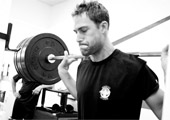It is no secret that you do not get better at a sport by not playing it, but a hockey workout frequency should not be so often that it creates undue stress on a player and leads to injury. Since hockey is a sport that emphasizes both cardiovascular capabilities and muscular performance (rather than a sport like baseball, which only emphasizes the latter), it is necessary for athletes to train both their heart and their limbs. A good frequency is one that leaves you tired after a workout, but fresh and ready for game days.
Hockey Workout Frequency Starts Off Ice
Whether you have the chance to skate every day on an ice rink or whether you only get one shot per week to get skating time, it is necessary to put in more time away from the rink than on it. Most pros spend about two hours off the ice working out for every one hour they spend on it. This is so that they can build their cardio and muscles, leaving the valuable ice time to hone their skating and shooting. No matter what your age or skill level, you can do low-level cardiovascular workouts every day without complications to your body or skill level. This includes light jogging, biking, or swimming.
Get The Most Out Of Hockey Workout Frequency
Lifting weights is an integral part of every hockey player’s routine. While forwards need the arm strength to get a strong shot on net, defensemen need to be able to overpower other players, while goalies need the burst speed from their limbs to stop pucks. The good news is that lifting weights is only a minor time investment. Lifting weights three times per week is often enough if you work out every muscle group. In fact, if you spend more than half an hour per session in the weight room, you are likely doing something wrong. Always give yourself at least one day to recover after lifting weights.
The Time On Ice
Since booking rink time is expensive, you need to maximize your use of the available time. If you can do drills at a stick time, spend at least half the time on your skating, increasing your ability to sprint on ice, your turning radius, your stopping power, and your ability to shoot on the rush. Spend the rest of the time puck-handling (if you are a forward) or practicing your checking (if you are a defenseman). Whenever it is possible to scrimmage, try to practice one new move or technique per shift. You can get more advice on hockey workout frequency, types of workouts, and the right way to train your body and mind for the sport through these services.
For more information on hockey workout frequency, call us on 1-888-588-0554 and we will be more than happy to help you.














